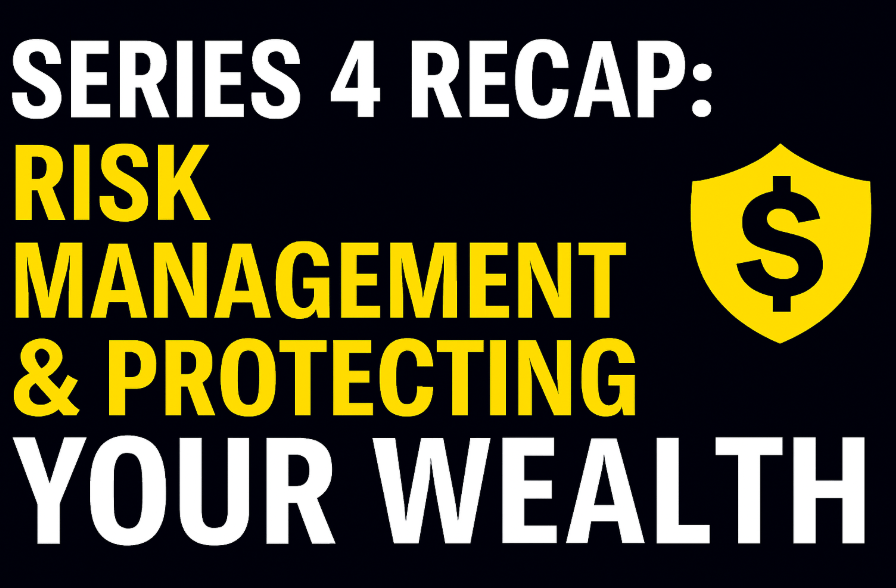- Live Life Grow Wealth
- Posts
- 🛡 Series 4 Recap: Risk Management & Protecting Your Wealth
🛡 Series 4 Recap: Risk Management & Protecting Your Wealth

Today’s Headline
🛡 Series 4 Summary: Risk Management & Protecting Your Wealth
Over the past seven days, we’ve gone through one of the most important parts of investing — managing risk and protecting your wealth. Because here’s the truth: anyone can make money when times are good, but it’s those who know how to manage risk that keep their wealth when times get tough.
In this series, we didn’t talk about “how to get rich quick.” Instead, we focused on something more meaningful — how to build lasting wealth without letting fear, greed, or bad decisions wipe away years of hard work. Let’s take a moment to look back at what we’ve learned and how it all connects together.
Want to get smarter — not just richer? Tap into curated financial wisdom from Money and stay ahead of the next big move in investing.
Start investing right from your phone
Jumping into the stock market might seem intimidating with all its ups and downs, but it’s actually easier than you think. Today’s online brokerages make it simple to buy and trade stocks, ETFs, and options right from your phone or laptop. Many even connect you with experts who can guide you along the way, so you don’t have to figure it all out alone. Get started by opening an account from Money’s list of the Best Online Stock Brokers and start investing with confidence today.
Day 1: Why Risk Is Inevitable — And How to Handle It
We started by accepting a simple truth — risk is part of life. Whether it’s crossing the road, starting a business, or investing your money, every choice carries some degree of uncertainty. There’s no such thing as “zero risk.”
The key is not to avoid risk, but to understand and manage it. We talked about how fear of risk keeps many people stuck in saving accounts earning near-zero returns. But on the other end, taking too much risk without a plan often leads to emotional decisions and losses.
I reminded readers that managing risk starts with knowing yourself — your goals, timeline, and comfort level. When you match your investments to who you are, you’ll find peace of mind even when markets get rough.
Day 2: Understanding Market Volatility
On Day 2, we explored something every investor experiences — market ups and downs. Many beginners panic when prices drop, thinking they’ve done something wrong. But market volatility is like the waves in the ocean — it’s normal, and it never disappears.
We discussed why volatility happens: economic news, interest rates, company earnings, or even global events can all move markets. But the most important lesson was this — volatility is not risk, unless you react emotionally to it.
Long-term investors see volatility as opportunity. When prices swing, disciplined investors can buy quality assets at a discount. The emotional ones, on the other hand, sell at the worst possible time. I shared that the best way to handle volatility is to stay focused on your long-term goals, not short-term noise.
Day 3: How Much Risk Is Too Much? (Risk Profiling Basics)
This day was all about self-awareness. Every person has a different risk tolerance — the amount of uncertainty they can handle before they lose sleep.
We broke down risk profiling into three simple categories:
Conservative investors — prefer stability and lower returns.
Balanced investors — accept moderate risk for moderate growth.
Aggressive investors — seek higher returns and can handle bigger ups and downs.
I explained how your age, income stability, financial goals, and emotional personality shape your profile. For example, a young professional might handle more volatility because they have time to recover. A retiree, however, may prefer steady income and safety.
Knowing your profile helps you avoid mistakes like over-investing in high-risk assets or holding too much cash out of fear. The goal isn’t to eliminate risk but to take the right amount for your life stage.
Day 4: Stop Loss vs. Long-Term Hold — When to Sell?
This lesson was about making one of the hardest decisions in investing — when to sell.
We compared two mindsets:
Stop-loss strategy — setting a limit to cut losses early.
Long-term holding — ignoring short-term drops and focusing on future growth.
I shared that both strategies have value. Stop-losses protect you from emotional panic and huge losses, especially in short-term trades. Long-term holding, on the other hand, rewards patience and faith in strong companies.
The key takeaway was that you need a plan before you invest. If you know why you bought something and what would make you sell, you won’t act out of fear or greed. Investing without an exit plan is like driving without brakes — sooner or later, you’ll crash.
Day 5: Why Emergency Funds Protect Your Investments
On Day 5, we talked about something most people overlook — having an emergency fund.
I explained how an emergency fund acts as your personal safety net. It prevents you from selling investments at the wrong time just to cover short-term needs like medical bills or job loss.
We discussed how much to save — ideally, 3 to 6 months of living expenses in cash or a liquid account. It’s not about earning returns from that fund; it’s about protecting the rest of your portfolio.
I also shared how having that safety net gives investors mental freedom. You can invest with confidence because you know that, no matter what happens, you won’t have to touch your long-term investments.
Get home insurance that protects what you need
Standard home insurance doesn’t cover everything—floods, earthquakes, or coverage for valuable items like jewelry and art often require separate policies or endorsements. Switching over to a more customizable policy ensures you’re paying for what you really need. Use Money’s home insurance tool to find the right coverage for you.
Day 6: Insurance as Part of Wealth Protection
Day 6 reminded us that wealth protection goes beyond investing — it’s also about preparing for life’s uncertainties.
We talked about insurance not as a cost, but as a tool for protection. When used wisely, insurance shields your family and your wealth from unexpected events like illness, accidents, or death.
I explained how different types of insurance serve different purposes:
Life insurance protects your loved ones from financial hardship.
Health insurance prevents medical bills from draining your savings.
Critical illness coverage helps you recover financially after major health events.
The message was simple — wealth building means nothing if one unfortunate event can erase it all. True financial success includes both growth and protection.
Day 7: Final Framework — Building Wealth While Staying Safe
In our final lesson, we put everything together into one powerful framework.
I reminded readers that smart investors don’t just chase returns — they build systems to stay safe and consistent. That means:
Diversifying across asset types.
Having clear goals and timeframes.
Preparing for the unexpected (insurance + emergency funds).
Managing emotions and staying disciplined through volatility.
I encouraged readers to think long-term — wealth is not built in days or months, but over years of steady decisions. The people who win in the financial game are not those who predict the future perfectly, but those who survive and stay in the game long enough to grow.
Final Takeaways
If there’s one message I want you to remember from this entire series, it’s this: wealth grows in calm, but it survives through storms.
Anyone can look smart in a bull market. But true success comes from learning how to manage risk, handle emotions, and make decisions based on logic, not fear. Protecting your wealth is just as important as growing it.
As we close this series, I want you to reflect — are your investments protected? Do you have an emergency fund? Are you insured? Do you have a clear plan for when to buy, hold, or sell?
If not, now’s the time to take action. Start with one small step — review your financial safety nets and make sure your foundation is strong. Because the stronger your protection, the more confidently you can grow your wealth.
Stay disciplined, stay educated, and remember: the best investors don’t avoid risk — they master it.
Call to Action:
If you’ve found this series helpful, stay tuned for the next part of our investment education journey. Share this with a friend who needs to hear it, and let’s continue building a future where your money not only grows — but stays safe for generations to come.
[Live Life Grow Wealth]
🎓 Free Masterclasses to Unlock Your Investment Potential
Take your money skills to the next level with expert-led workshops designed to help you grow smarter and faster.
Recommendations Section
|
|
|
DISCLAIMER
I make no representations, warranties, or guarantees, whether expressed or implied, that the content provided is accurate, complete, or up-to-date. Past performance is not indicative nor a guarantee of future returns.
I am an individual content creator and not regulated or licensed by the Monetary Authority of Singapore (MAS) as I do not provide investment services.
All forms of investments carry risks, including the risk of losing your entire invested amount. Such activities may not be suitable for everyone. You are strongly encouraged to seek advice from a professional financial advisor if you have any doubts or concerns.








